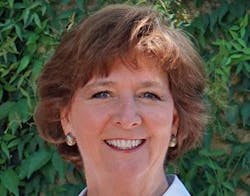In the announcement, posted to the organization’s website, Donald C. Wegmiller, chairman of the Scottsdale Institute, stated that, when the COVID-19 pandemic emerged in the United States, “Janet quickly and successfully pivoted SI to a dynamic virtual organization in order to address our members’ needs as they fought the worst surges of the pandemic. Janet’s leadership has won health executives’ admiration and respect and further solidified SI’s reputation as a convenor of the right people on the right issues at the right moment,” Wegmiller added.
And Tom Sadvary, vice chairman of SI and a retired health-system CEO, said that the promotion rightfully reflected Guptill’s success in engaging senior health system executives. “Janet has demonstrated the acumen, intelligence and grace to interact with the most innovative and respected leaders in the healthcare industry,” he said.
“I’m honored and humbled to accept this promotion as president and CEO of Scottsdale Institute,” Guptill said. “We have learned so much and yet still have so much to learn on our members’ journey to a digitally-enabled healthcare system that is accessible and equitable for all.”
At the same time, the Scottdale Institute also announced the appointment of two new members to its Board of Directors, both of whom are highly regarded healthcare leaders nationally: Tom Priselac, president & CEO of Cedars-Sinai Health System in Los Angeles, and Howard Kern, president & CEO of Sentara Healthcare in Norfolk, Va.
As the organization’s description notes, “The Scottsdale Institute (SI) is a not-for-profit membership organization of prominent healthcare systems whose goal is to support our members as they strive to achieve clinical integration and transformation through information technology (IT). SI facilitates knowledge-sharing by providing intimate and informal forums that embrace SI’s ‘Three Pillars’: collaboration, education, and networking.”
Shortly after the announcement of her promotion was made, Janet Guptill spoke with Healthcare Innovation Editor-in-Chief Mark Hagland regarding current developments at the Scottsdale Institute, and her perspectives on the present landscape in U.S. healthcare. Below are excerpts from that interview.
When did your title change officially?
We had a board meeting on July 28. It required a bylaws change. The executive committee of the board, which meets monthly, had been working on this for the whole last year. They saw how relevant we had been to our members, because as things had been changing so regularly, even on a weekly basis, it was so valuable for people to learn from those markets that might be a day or week ahead of them. We’ve converted completely to virtual, including through our affinity-group summits—which are organized a common title like CIOs, or a common topic, like innovation. And to be able to do that virtually, via Zoom, has been painless, and seamless, and exciting, and our members have really felt it’s served their needs.
What are your members looking for right now?
We started as a collaboration of large integrated health systems, focused on CEOs and CIOs, and focusing on population health, and how e can do that in terms of achieving common infrastructure. That’s all so obvious today: you have to have the IT infrastructure in place to enable everything. The fact that we could pivot to a remote workforce and could pivot towards remote care wherever possible—and that we’ve reworked how COVID-19 treatment care is delivered—all of that is dependent on IT to facilitate it.
And we had a CHIO say to us, rather than talking about what’s changed because of COVID, we should rally talk about what hasn’t changed; and how has the role of the CIO had to pivot? So what our members want to talk about is that future, and where our members are headed, and how we’re refocusing continually to be a more nimble organization.
And one of our advisers, a CIO, said, we used to think about flexing up and down as needed; we flex up and down daily now. When you think about what it takes to adapt to COVID conditions—that need to flex up and down is happening daily. And so many of your costs are fixed costs. And as we move to the cloud, those expenses become fixed expenses. So you have to get a lot more creative.
What do you see as the biggest challenges for your members in the next five years?
One of the things is this governance question. Healthcare is inherently a collaborative business; you have to have a governance process for making decisions about what our standard operating procedure is, what the analytics are to drive that, what tools are needed, and you have to make those decisions quickly, but they have to make sense for everybody. So you have to spend a lot of time thinking about the governance model; so governance models are critical. Another related topic is literacy around data and technology, so upping everyone’s game around data definitions, analytics, and metrics, and helping everyone to become more fluent around the terms and concepts.
So the entire c-suite has to learn that, correct?
Exactly. I think the CIO’s role is so different now, because they’ve become the adviser to the entire c-suite. And there’s a technology piece to conducting staff meetings when everyone’s remote; things like that. And even when we do have in-person meetings, how do we make those meetings much more purposeful.
One adviser we talked with just yesterday said the CEO, COO, CFO, and CIO are really making all the decisions in his organization. And My role is to help reduce total cost of care. And his other major point was around the need to diversify the company. And that’s his charge as the CIO. And that’s not typical something you feel is owned by the CIO. So that’s enlightening. And he’s still doing the day-to-day stuff.
It feels as though there’s more pressure on CIOs than ever before, correct?
Absolutely. They’re modernizing their infrastructure to prepare for the future; they’re teaching their organization how to become more literate. And they’re looking towards what the enterprise of the future will be. And another advisor told us, this digital enterprise is like a parallel universe for us. We’re still a healthcare enterprise, we’re just virtual now. And all the same infrastructure is needed. It’s fascinating; so much more complex.
What do you hope to accomplish as an organization, in the next five years?
Inherently, what our members want for us is for us to help them get to the right person, and to convene the right people, right time, right topic, to brainstorm; and also, where am I on my journey? Who are my peers working with similar issues? At any given point in time, all of our members are on a similar journey, just at a different pace; so at any given time, all of our members are both teachers and learners simultaneously. So they want us to help them map out the future, and they want to hear it from their peers. Because hearing it from someone in their shoes is so much more valuable.
Sometimes it’s just that single conversation that helps you clear a logjam; and they didn’t need a whole project around it, they just needed that one little insight. So our vision is around continuing to convene people for what they need. We’re not trying to be all things to all people, but to bring together leaders of like organizations, and to help them deepen their understand of their journey. So we know who the population health person is, and the informatics person, and the innovation person, and all of those points provide us with a collective view; and therefore, we can be that much more valuable.
So they want to be able to converse together as a community? I remember ten years ago, when you would do a ten-year plan; that doesn’t even make sense anymore.
Yes, we did a webinar yesterday, and we had some CIOs and chief digital officers talking about digital transformation. And what they all acknowledged was, you’ve got to be comfortable with ambiguity, because you have to constantly make strategic adjustments. So you have to think both strategically and operationally every single day. And tactically, how do I make day-to-day decisions for the next month, quarter, or year? And we know that some basic modernization has to be done.
How do you feel about all of this personally?
It’s exciting, it’s invigorating, it’s an incredible honor to have my board be pushing in this direction. My board is saying, Janet, we know you’ve been capable of organizing and managing what we have; you’ve done a magnificent job of managing the legacy of what we have. But we want to free you up day to day, and spend more time with the CEOs and whole executive team, because painting that picture of where people need to go, is more important than ever before. There’s just a greater strength in numbers. No one alone can change the industry; but collectively, we can all change the industry. So it’s being in sync with our members and being able to bounce back and forth between the strategic and the operational. So I’m humbled by the challenges, but honored by their confidence.



